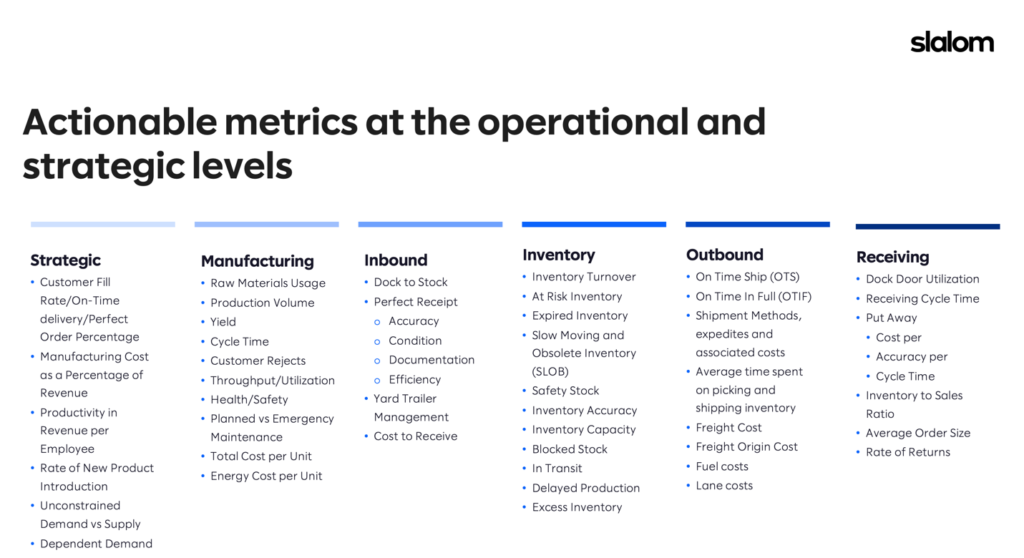Optimizing Supply Chains for Performance and Sustainability
By David Frigeri, Managing Director, Slalom
Introduction
Never has the saying “Strategy is for amateurs and logistics is for professionals” been more spot on. For at least the last five years, we have seen a ratcheting up of pressure on our supply chains, from trade wars to the pandemic to an increased focus on sustainability. During this period, the organizations underinvested in data and analytics have exposed their businesses to a heightened risk of lost sales, increased unit costs, and dissatisfied customers. In this article, I will share how improving the performance of supply chains can be viewed as an analytics optimization opportunity, where we seek to simultaneously increase throughput and sustainability while reducing operating and inventory expenses.
Background on Supply Chains and Data
In its simplest form, a supply chain is composed of suppliers and customers, and the ability for products or parts to move through various processes has upstream and downstream impacts when not executed optimally. As a product moves through the supply chain, various pieces of data are captured so it can be tracked and accounted for. Often that data is siloed, significantly delayed, difficult to access, and/or cannot be aggregated with another product’s data (e.g., cross-docking moving through the supply chain).
With few exceptions, most companies have moved from vertical integration to virtual integration, where the priority is placed on core competencies while the rest is ‘outsourced.’ As this shift has occurred, insufficient data integration creates black holes and gaps in data from one player to the next, as well as within each player’s own processes.
Many of these organizations have struggled to do real-time reporting on data from ERP systems like SAP and Oracle, creating gaps in the inventory moving through distribution centers, which leads to perplexing operational questions such as “why does an order just stop in transit for days?” These gaps can result in unfulfilled orders, financial penalties, lost revenue, and critical shortages ranging from medications to empty shelves in retail stores. There is a similar impact on the demand side, where organizations have increasingly been surprised by inbound demands that a modern data strategy would have identified, providing the opportunity and levers to take appropriate action.
Optimizing End-to-End Supply Chain
Supply chains can be simplified into production, inventory, location, and transportation, representing opportunities for improved data capabilities and optimization across each step. Production optimization identifies a balance between responsiveness and efficiency, where having excess capacity allows for flexibility and responsiveness but at increased costs while running the facility at maximum utilization can fail to opportunistically capture changes in customer demands or preferences.
Inventory optimization minimizes the costs of carrying extra inventory while maximizing the sales or throughput. If done well, it can also positively impact energy consumption and carbon emissions from transportation.
Due to the longer-term commitment, location optimization is arguably the most strategic route, requiring the consideration of a broad range of data factors, including the availability of human capital, proximity to suppliers and stores, and, increasingly, the presence of renewable energy. Location optimization examines the number of facilities that determine efficiencies in scale and carbon emissions, identifying if being closer to customers and suppliers to increase responsiveness positively impacts sustainability.
In transportation, the tradeoff between responsiveness and efficiency manifests in the choice of transport mode and the carrier itself. Fast modes of transportation, such as airplanes, are very responsive but are more costly with higher emissions. Slower modes, such as ships and rail, are very cost-efficient with lower emissions but less responsive. In addition, route optimization, including time of day and distance, can help solve for lower delivery costs and create a smaller carbon footprint.
Data and analytics are critical for optimizing the four supply chain drivers. Done properly, data provides the accessibility, transparency, connections, and foresight to rapidly react and act prospectively to capture market opportunities and minimize risks.
Using data to optimize the supply chain, in essence, is getting the right insights to the right people at the right time. Establishing a strong data foundation ensures you have a complete, accessible, and high-quality supply chain picture. Building the advanced analytics to optimize your supply chain starts with identifying the key measures to be improved. Below is an array of measures to pay attention to – some measures may natively be in your dataset, while others may need to be calculated and added to your data. The algorithms used to build the insights already exist today within demand forecasting and time-series anomaly detection technology like Profet, Random Forest, SARIMA, or LSTM.

Delivering timely insights requires a mix of integration, data sharing, a lot of collaboration, and potentially some negotiation with your business partners. There are providers with proven capabilities to accelerate your entire supply chain optimization journey, including Snowflake, Amazon Web Services, and Microsoft Azure. They are also committed to zero emissions and provide options for minimizing your carbon footprint when using their services.
Finally, and most importantly, a sustainable approach to optimizing supply chains must start with what’s best for people and our planet. Using data to improve supply chains can make your employee experience more productive and engaging by removing remedial tasks and providing a forum for collaboration while simultaneously using our natural resources more responsibly, efficiently, and effectively – not only because it is the right thing to do but because we know happier, healthier, and more connected employees are more productive and better decision-makers that are all prerequisites for a higher-performing supply chain.
_______________________________________________________
About David Frigeri – David is a Managing Director in Slalom’s Data and Analytics practice, focused on helping enterprise organizations use data to dream bigger, move faster, and build better tomorrow for all. Slalom is a global consulting firm focused on strategy, technology, and business transformation. In 41 markets worldwide, Slalom’s teams have the autonomy to move fast and do what’s right. Slalom has been named one of Fortune’s 100 Best Companies to Work For six years running and is regularly recognized by employees as the best place to work. Learn more at slalom.com

